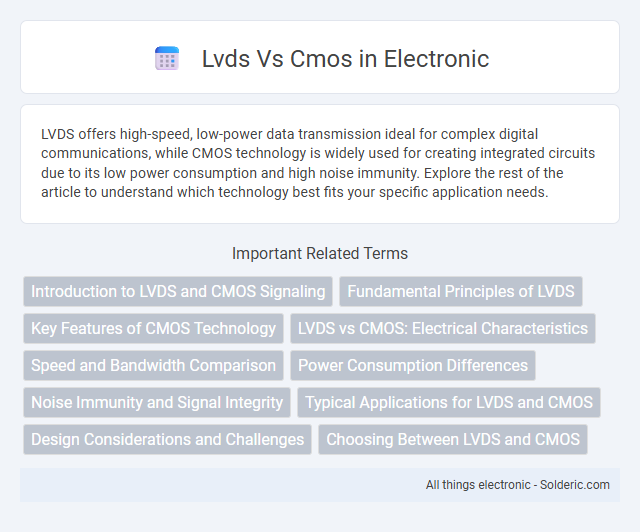LVDS offers high-speed, low-power data transmission ideal for complex digital communications, while CMOS technology is widely used for creating integrated circuits due to its low power consumption and high noise immunity. Explore the rest of the article to understand which technology best fits your specific application needs.
Comparison Table
| Feature | LVDS (Low-Voltage Differential Signaling) | CMOS (Complementary Metal-Oxide-Semiconductor) |
|---|---|---|
| Signal Type | Differential | Single-ended |
| Voltage Level | Low voltage (typically 350mV) | Higher voltage (typically 1.8V to 3.3V) |
| Power Consumption | Low power | Moderate to high power |
| Data Rate | High speed, up to several Gbps | Moderate speed, usually up to hundreds of Mbps |
| Noise Immunity | Excellent, due to differential signaling | Lower, more susceptible to noise |
| Application | High-speed data transmission, displays, communications | General-purpose digital circuits, sensors, memory |
| Cable Length | Supports longer cables (up to several meters) | Shorter cable lengths preferred |
| Complexity | More complex receiver and transmitter design | Simpler design, easier integration |
Introduction to LVDS and CMOS Signaling
LVDS (Low-Voltage Differential Signaling) and CMOS (Complementary Metal-Oxide-Semiconductor) represent two fundamental signaling technologies used in electronic communications. LVDS transmits data using differential signals at low voltage levels, enabling high-speed, noise-resistant communication across circuit boards and cables. CMOS signaling relies on single-ended voltage levels within integrated circuits, offering lower power consumption but generally slower data rates compared to LVDS.
Fundamental Principles of LVDS
LVDS (Low-Voltage Differential Signaling) operates by transmitting data through differential pairs, using low voltage swings typically around 350 mV, which minimizes power consumption and electromagnetic interference. This method contrasts with CMOS logic, which uses single-ended signals with higher voltage levels and larger swings, leading to greater power usage and noise susceptibility. Understanding LVDS's fundamental principle of utilizing differential signaling helps optimize Your circuit designs for high-speed, low-noise data transmission.
Key Features of CMOS Technology
CMOS technology features low power consumption, high noise immunity, and excellent scalability, making it ideal for integrated circuits in digital devices. Its high integration density allows for complex chip designs, while the complementary structure enables efficient switching with minimal static power loss. Your choice of CMOS technology ensures reliable performance in applications ranging from microprocessors to image sensors.
LVDS vs CMOS: Electrical Characteristics
LVDS (Low-Voltage Differential Signaling) operates with low voltage swings around 350mV and uses differential signaling for high noise immunity and low electromagnetic interference (EMI), making it ideal for high-speed data transmission. CMOS (Complementary Metal-Oxide-Semiconductor) typically uses single-ended signaling with voltage levels close to the supply voltage (e.g., 3.3V or 5V) and is more susceptible to noise but offers simple integration and low power consumption at slower speeds. Your choice between LVDS and CMOS depends on the need for speed, power efficiency, and robustness in electrical noise environments.
Speed and Bandwidth Comparison
LVDS offers significantly higher speed and bandwidth than CMOS, supporting data rates up to several gigabits per second per channel, making it ideal for high-speed data transmission in applications like video and telecommunications. CMOS technology typically operates at lower speeds with bandwidth limitations due to higher power consumption and noise susceptibility, restricting its use in high-frequency scenarios. Your choice between LVDS and CMOS should consider the required data throughput and signal integrity for your specific application.
Power Consumption Differences
LVDS (Low-Voltage Differential Signaling) consumes significantly less power compared to CMOS (Complementary Metal-Oxide-Semiconductor) due to its differential signaling method, which reduces voltage swings and current flow. CMOS circuits typically require higher voltage levels and continuous current to maintain logic states, leading to greater overall power usage. Understanding these power consumption differences can help you optimize your electronic designs for energy efficiency and thermal management.
Noise Immunity and Signal Integrity
LVDS offers superior noise immunity compared to CMOS due to its differential signaling, which effectively cancels out common-mode noise and reduces electromagnetic interference. This results in enhanced signal integrity, especially over longer distances or in electrically noisy environments. CMOS, relying on single-ended signaling, is more susceptible to noise, leading to potential signal degradation and timing errors.
Typical Applications for LVDS and CMOS
LVDS (Low-Voltage Differential Signaling) is typically used in high-speed communication applications such as data transmission in flat-panel displays, camera interfaces, and high-performance computing due to its low power consumption and minimal electromagnetic interference. CMOS (Complementary Metal-Oxide-Semiconductor) technology is widely employed in general-purpose digital circuits, including microprocessors, memory chips, and analog-to-digital converters, valued for its scalability and integration density. LVDS excels in scenarios demanding high data rates and signal integrity, while CMOS dominates in cost-sensitive, low-power, and high-integration applications.
Design Considerations and Challenges
LVDS offers low power consumption and high-speed data transmission, making it ideal for high-frequency applications, but it requires careful impedance matching and noise reduction in the PCB design. CMOS is favored for its low cost and ease of integration, yet it faces challenges with higher power consumption and slower data rates compared to LVDS. Your choice depends on balancing signal integrity requirements, power budgets, and system complexity for optimal performance.
Choosing Between LVDS and CMOS
Choosing between LVDS and CMOS depends on your need for data transmission speed and power efficiency. LVDS offers high-speed data transfer with low noise and power consumption, making it ideal for applications like high-resolution displays and communication interfaces. CMOS is suitable for lower-speed, cost-sensitive designs where integration and simplicity are prioritized.
lvds vs cmos Infographic

 solderic.com
solderic.com